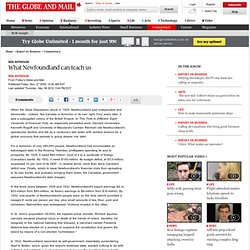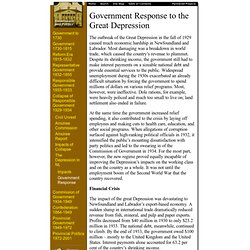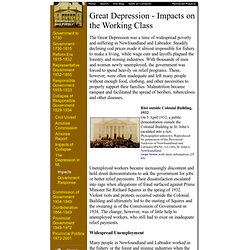

What Newfoundland can teach us. When the Great Depression struck in 1929, Newfoundland was independent and democratic - indeed, like Canada, a dominion in its own right.

Four years later, it was a subjugated colony of the British Empire. In This Time Is Different: Eight Centuries of Financial Folly, an especially perceptive work, Harvard University's Kenneth Rogoff and University of Maryland's Carmen Reinhart cite Newfoundland's spectacular decline and fall as a cautionary tale laden with sombre lessons for a global economy that persists in going deeper into debt. For a dominion of only 280,000 people, Newfoundland had accumulated an extravagant debt in the Roaring Twenties, profligately spending its way to prosperity. By 1929, it owed $85-million, most of it to a syndicate of foreign (Canadian) banks. By 1932, it owed $100-million. In the three years between 1929 and 1932, Newfoundland's export earnings fell to $20-million from $40-million, its fishery earnings to $6-million from $16-million. In St. The Great Depression, the Economic Collapse of Newfoundland and its Loss of Responsible Government.
Government Response to the Great Depression: Newfoundland and Labrador Heritage. Government Response to the Great Depression The outbreak of the Great Depression in the fall of 1929 caused much economic hardship in Newfoundland and Labrador.

Most damaging was a breakdown in world trade, which caused the country’s revenue to plummet. Despite its shrinking income, the government still had to make interest payments on a sizeable national debt and provide essential services to the public. Widespread unemployment during the 1930s exacerbated an already difficult situation by forcing the government to spend millions of dollars on various relief programs. Most, however, were ineffective. At the same time the government increased relief spending, it also contributed to the crisis by laying off employees and making cuts to health care, education, and other social programs. Financial Crisis The impact of the great Depression was devastating to Newfoundland and Labrador’s export-based economy. The government responded to the crisis by borrowing more money from abroad.
Great Depression – Impacts on the Working Class: Newfoundland and Labrador Heritage. Great Depression - Impacts on the Working Class The Great Depression was a time of widespread poverty and suffering in Newfoundland and Labrador.

Steadily declining cod prices made it almost impossible for fishers to make a living, while wage cuts and layoffs plagued the forestry and mining industries. With thousands of men and women newly unemployed, the government was forced to spend heavily on relief programs. These, however, were often inadequate and left many people without enough food, clothing, and other necessities to properly support their families. Malnutrition became rampant and facilitated the spread of beriberi, tuberculosis and other diseases.
Unemployed workers became increasingly discontent and held street demonstrations to ask the government for jobs or better relief payments. Widespread Unemployment Many people in Newfoundland and Labrador worked in the fishery or the forest and mining industries when the Great Depression broke out in 1929. Impacts of the Collapse of Responsible Government: Newfoundland and Labrador Heritage. Impacts of the Collapse of Responsible Government The replacement of responsible government with the non-elected Commission of Government in 1934 had far-reaching consequences for Newfoundland and Labrador society, economy, and politics.

The Commission remained in power for 15 years, during which time the Second World War brought much economic prosperity to the country and helped integrate it into North American society. Although contact with Canada and the United States increased dramatically during the 1940s and helped shape Newfoundland and Labrador's future, it was largely controlled by the commissioners. It was not until 1946 that the people returned to the polls to elect members of the National Convention. By then, almost half of all eligible voters had never cast a ballot before, having been too young to participate in the previous election 14 years earlier. End of Responsible Government Initial Reaction The change initially sparked little protest from the public. Growing Discontent.